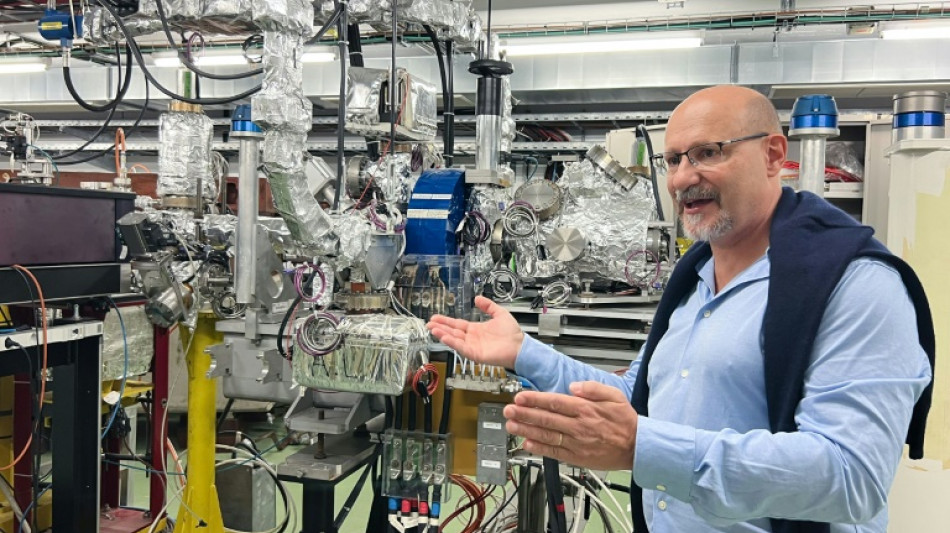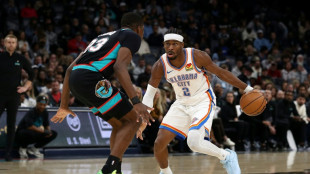
-
 Tanzania Maasai fear VW 'greenwashing' carbon credit scheme
Tanzania Maasai fear VW 'greenwashing' carbon credit scheme
-
Chinese businesswoman faces jail after huge UK crypto seizure

-
 Markets boosted by hopes for deal to end US shutdown
Markets boosted by hopes for deal to end US shutdown
-
Amazon poised to host toughest climate talks in years

-
 Ex-jihadist Syrian president due at White House for landmark talks
Ex-jihadist Syrian president due at White House for landmark talks
-
Saudi belly dancers break taboos behind closed doors

-
 The AI revolution has a power problem
The AI revolution has a power problem
-
Big lips and botox: In Trump's world, fashion and makeup get political

-
 NBA champion Thunder rally to down Grizzlies
NBA champion Thunder rally to down Grizzlies
-
US senators reach deal that could end record shutdown

-
 Weakening Typhoon Fung-wong exits Philippines after displacing 1.4 million
Weakening Typhoon Fung-wong exits Philippines after displacing 1.4 million
-
Lenny Wilkens, Basketball Hall of Famer as player and coach, dies

-
 Griffin wins PGA Mexico title for third victory of the year
Griffin wins PGA Mexico title for third victory of the year
-
NFL makes successful return to Berlin, 35 years on

-
 Lewandowski hat-trick helps Barca punish Real Madrid slip
Lewandowski hat-trick helps Barca punish Real Madrid slip
-
George warns England against being overawed by the All Blacks

-
 Lewandowski treble helps Barca beat Celta, cut gap on Real Madrid
Lewandowski treble helps Barca beat Celta, cut gap on Real Madrid
-
Neves late show sends PSG top of Ligue 1, Strasbourg down Lille

-
 Inter go top of Serie A after Napoli slip-up
Inter go top of Serie A after Napoli slip-up
-
Bezos's Blue Origin postpones rocket launch over weather

-
 Hamilton upbeat despite 'nightmare' at Ferrari
Hamilton upbeat despite 'nightmare' at Ferrari
-
Taylor sparks Colts to Berlin win, Pats win streak hits seven

-
 Alcaraz and Zverev make winning starts at ATP Finals
Alcaraz and Zverev make winning starts at ATP Finals
-
Protests suspend opening of Nigeria heritage museum

-
 Undav brace sends Stuttgart fourth, Frankfurt win late in Bundesliga
Undav brace sends Stuttgart fourth, Frankfurt win late in Bundesliga
-
Roma capitalise on Napoli slip-up to claim Serie A lead

-
 Liverpool up for the fight despite Man City masterclass, says Van Dijk
Liverpool up for the fight despite Man City masterclass, says Van Dijk
-
Two MLB pitchers indicted on manipulating bets on pitches

-
 Wales rugby captain Morgan set to be sidelined by shoulder injury
Wales rugby captain Morgan set to be sidelined by shoulder injury
-
After storming Sao Paulo podium, 'proud' Verstappen aims to keep fighting

-
 US flights could 'slow to a trickle' as shutdown bites: transport secretary
US flights could 'slow to a trickle' as shutdown bites: transport secretary
-
Celtic close on stumbling Scottish leaders Hearts

-
 BBC chief resigns after row over Trump documentary
BBC chief resigns after row over Trump documentary
-
Norris extends title lead in Sao Paulo, Verstappen third from pit-lane

-
 Norris wins in Sao Paulo to extend title lead over Piastri
Norris wins in Sao Paulo to extend title lead over Piastri
-
Man City rout Liverpool to mark Guardiola milestone, Forest boost survival bid

-
 Man City crush Liverpool to mark Guardiola's 1,000 match
Man City crush Liverpool to mark Guardiola's 1,000 match
-
Emegha fires Strasbourg past Lille in Ligue 1

-
 Howe takes blame for Newcastle's travel sickness
Howe takes blame for Newcastle's travel sickness
-
Pumas maul Wales as Tandy's first game in charge ends in defeat

-
 'Predator: Badlands' conquers N. American box office
'Predator: Badlands' conquers N. American box office
-
Liga leaders Real Madrid drop points in Rayo draw

-
 'Killed on sight': Sudanese fleeing El-Fasher recall ethnic attacks
'Killed on sight': Sudanese fleeing El-Fasher recall ethnic attacks
-
Forest boost survival bid, Man City set for crucial Liverpool clash

-
 US air travel could 'slow to a trickle' as shutdown bites: transport secretary
US air travel could 'slow to a trickle' as shutdown bites: transport secretary
-
Alcaraz makes winning start to ATP Finals

-
 'I miss breathing': Delhi protesters demand action on pollution
'I miss breathing': Delhi protesters demand action on pollution
-
Just-married Rai edges Fleetwood in Abu Dhabi playoff

-
 All aboard! Cruise ships ease Belem's hotel dearth
All aboard! Cruise ships ease Belem's hotel dearth
-
Kolo Muani drops out of France squad with broken jaw


Particle physics pushing cancer treatment boundaries
Researchers at Europe's science lab CERN, who regularly use particle physics to challenge our understanding of the universe, are also applying their craft to upend the limits to cancer treatment.
The physicists here are working with giant particle accelerators in search of ways to expand the reach of cancer radiation therapy, and take on hard-to-reach tumours that would otherwise have been fatal.
In one CERN lab, called CLEAR, facility coordinator Roberto Corsini stands next to a large, linear particle accelerator consisting of a 40-metre metal beam with tubes packed in aluminium foil at one end, and a vast array of measurement instruments and protruding colourful wires and cables.
The research here, he told AFP during a recent visit, is aimed at creating very high energy beams of electrons -- the negatively charged particles in the nucleus of an atom -- that eventually could help to combat cancerous cells more effectively.
They are researching a "technology to accelerate electrons to the energies that are needed to treat deep-seated tumours, which is above 100 million electron volts" (MeV), Corsini explained.
The idea is to use these very high energy electrons (VHEE) in combination with a new and promising treatment method called FLASH.
- Reducing 'collateral damage' -
This method entails delivering the radiation dose in a few hundred milliseconds, instead of minutes as is the current approach.
This has been shown to have the same destructive effect on the targeted tumour, but causes far less damage to the surrounding healthy tissue.
With traditional radiation therapy, "you do create some collateral damage," said Benjamin Fisch, a CERN knowledge transfer officer.
The effect of the brief but intense FLASH treatment, he told reporters, is to "reduce the toxicity to healthy tissue while still properly damaging cancer cells."
FLASH was first used on patients in 2018, based on currently available medical linear accelerators, linacs, that provide low-energy electron beams of around 6-10 MeV.
At such low energy though, the beams cannot penetrate deeply, meaning the highly-effective treatment has so far only been used on superficial tumours, found with skin cancer.
But the CERN physicists are now collaborating with the Lausanne University Hospital (CHUV) to build a machine for FLASH delivery that can accelerate electrons to 100 to 200 MeV, making it possible to use the method for much more hard-to-reach tumours.
- 'Game-changer' -
Deep-lying cancer tumours that can't be rooted out using surgery, chemotherapy or traditional radiation therapy are often today considered a death sentence.
"It is the ones which we don't cure at the moment which will be the targets," Professor Jean Bourhis, head of CHUV's radiology department, told AFP.
"For those particular cancers, which may be one third of the cancer cases, it could be a game-changer."
There are particular hopes that the FLASH method, with its far less harmful impact on surrounding tissue, could make it possible to go after tumours lodged in the brain or near other vital organs.
Bourhis said it might not relegate deaths from stubborn cancer tumours to the history books, "but at least there will be a new opportunity for more cures, if it works."
- 'Compact' -
One challenge is making the powerful accelerator compact enough to fit inside a hospital.
At CERN, a large gallery has been dedicated to housing the CLEAR accelerator, which requires 20 metres to push the electrons up to the required energy level -- and another 20 metres to condition, measure and deliver the beam.
But Corsini insisted that CERN had the know-how to "accelerate in a much more compact space".
The prototype being designed with CHUV will aim to do the same job with a machine that is 10 metres overall.
This "compact" solution, Corsini said, "reduces the cost, reduces power consumption and variability, and you can easily put it into a hospital without having to build a whole building."
Construction of the prototype is scheduled to begin next February, and patient clinical trials could begin in 2025, Bourhis said, "if everything goes smoothly".
F.Dubois--AMWN



